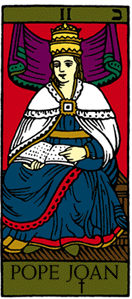THE HISTORICAL BACKGROUND OF POPE JOAN
The Setting
In the year 855, Europe was dominated by three great powers:
the Roman Catholic Church, the remnants of Charlemagne's Holy
Roman Empire, and the marauding pagan tribes of Northern and
Eastern Europe. The Church had grown to its position of power
and influence by filling the vacuum left by the collapse of the
old Roman Empire. Originally an underground institution forced
to worship in secret in the old city, the Church was legalized
with the conversion of the Emperor Constantine, who re-located
the center of the declining empire to Constantinople.
After Constantine, free to operate in public, the Church gradually began to assume many of the civil functions no longer performed by the government. In a document known as "The Donation of Constantine," the Church was given total political as well as spiritual authority over all things in the Western empire. By the year 800, they had taken control of most of Europe, despite periodic sacking of the city by the Goths or the Saracens of Africa. At this time, however, the great Frankish king, Charlemagne, conquered much of this territory in the name of the Church. The Pope, being somewhat uneasy at this accumulation of power in one man, offered to crown Charlemagne as Holy Roman Emperor, and thereby appear to put him at the service of the Pope. Charlemagne refused, but in a clever maneuver, the Pope produced a crown and crowned the unsuspecting monarch publicly anyway. This established the precedent for Charlemagne's heirs to need the Pope's approval to ascend to the title of Holy Roman Emperor. His heirs needed the Pope's blessing as much as the Church needed the Empire's armies and funds.
The character of Louis is the historical Louis II,
great-grandson of Charlemagne, actually crowned in the year 855.
The character of Anastasius was indeed Anastasius
Bibliothecarius, a Roman prelate who was briefly made pope and
then deposed in the year 855. The character of Nicholas is the
historical Pope Nicholas I, whose vision and organizational
ability enabled the Church to wrest itself from the influence of
the Holy Roman Empire and become the dominant political force of
the Dark Ages until the Reformation. He was canonized a saint.
The infamous
Donation of Constantine, upon which the whole
concept of the Church as a sovereign state is founded, was
indeed discovered to be a forgery.

Historical Suppression of Facts?
Those are the basic historical facts -- but what is historical
"fact?" What is legend and myth? Where does fact end and
fiction begin? And who assembles and reports the facts upon
which the history is assembled and labels them as truth? Can
the facts of history be rewritten, depending upon who is
recording them? Modern history is full of examples of stories
emphasized (or suppressed) by the writers of that history --
Russia (before, during and after various revolutionary phases)
and Japan/Germany (in relation to World War II). Traditional
American history, absent stories of women and people of color,
is being supplemented. The victors in any conflict are the ones
who write the final story -- one that usually places them in the
most favorable light. Consider: how much more potentially
convoluted are stories with a thousand years between us and
their source? The history of the Roman Catholic Church and the
papacy was written by the men within the institution itself. It
is fascinating, then, to propose that it be re-examined. What
should be done with the multiple legends of a female pope
commonly called Joan?

Care to comment or leave a message? Visit the Pope Joan Post Office
Register now for updates and information

